
This featured game came out in 2012, but let's go back for a moment to the 1990s. You've got ZZT and you're looking for something new to play. The main ZZT archive offers monolithic lists of titles and genres that don't give you much to go on. If you're lucky, one of the smaller sites that offers a hand picked list of games to enjoy might have some screenshots of a title screen or two.
You're on dial-up internet, but ZZT worlds are pretty small and even the larger worlds only take a few minutes at most to download. For the most part, you have to pick blindly, slowly learning author names to look out for, or gambling on an interesting sounding title
It's the old fashioned way to find a ZZT world, and today on the Museum here you can see title screens of every game, are a click away from just playing the world in your browser, or two clicks away from browsing the ZZT file in the zip and just combing through boards. It's a remarkably different experience, but sometimes the old ways still shine through.
I didn't know what ZZT world I wanted to play to write about, and figured I'd try to play something "recent" (2012 was 7 years ago now good lord). I set my filter to 2012, sorted by release date, and the first thing that caught my eye was the strangely named Evilstania
Rather than dive right in to the ZZT file, I decided to take a look at the game's text file first. Modern ZZT worlds tend to be a little better about including information beyond the mandatory info required to be accepted on z2, and I quickly found myself loading up the game.
Evilstania is a dungeon-crawling action game, with light RPG and Survival Horror elements. Only you can save Princess Girlfriend from the clutches of the nefarious Baron Von Dread!
Evilstania is silent, like one of those classy arthouse films. Game sounds may safely be disabled.
I've always been a fan of ZZT dungeon crawlers, and the genre has a good number of games as its something ZZT handles fairly well. For a game in 2012 to compete with the classics, it would have to do something to stand out among the dozen of others out there. I didn't actually expect the first game I looked at with a 2012 release year to be the game I played, but it captivated me in a way few ZZT games have before.
Kill enemies by shooting them; you take damage if they touch you. You start the game with a maximum health of only 20, meaning that two hits will kill you - buy armor to increase your Max HP! Killing enemies in the dungeon gives you points; you can return to town at any time to exchange your points for supplies, healing, and upgrades. The game consists of four Levels, each of which is divided into five Stages. At the end of each Level, you'll fight a powerful Boss monster; kill him to gain his key and proceed to the next Level!
Evilstania, the first and only release by Weaselfeathers brings to the ZZT dungeon crawl what Commodore brought to action titles with Angelis Finale and RPGs with Psychic Solar War Adventure. That is, it pushes the boundaries of what the genre means in ZZT to a point where you feel like you're playing something that isn't ZZT. The game holds its own without those pesky reminders of all the bugs and limitations ZZT has that can make it hard for outsiders to appreciate. This game does so much so well that I had to turn it into a featured title, and can't recommend it enough.
Like the text file says, the core gameplay loop of the game is going into the dungeon, defeating (hopefully an entire room's worth of) monsters, and then using the score they give to return to town, rest up, purchase supplies, and build your character.
We're talking ZZT Diablo here, in a way that feels natural, fun, and challenging.
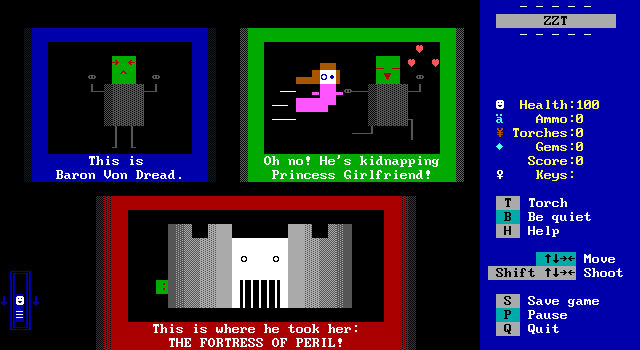
The game's story is deliberately as barebones as it gets, and told through an opening vignette of still images. Baron Von Dread has captured Princess Girlfriend and it's up to you to rescue her. Admittedly, while clearly tongue-in-cheek, it is still playing into the same old rescue the damsel trope, and acknowledging itself as being so generic and overdone as a plot device doesn't make it any less so, but this is a game whose story never comes up again until the ending.
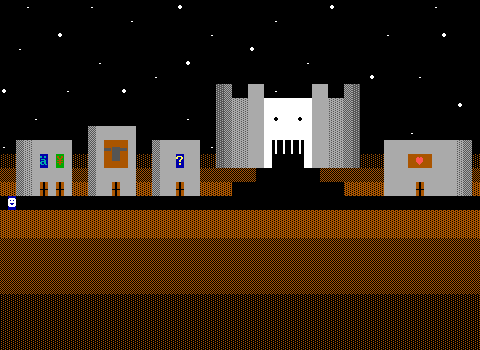
The player starts at the town just outside the fortress which contains the dungeons to conquer. You'll be low on supplies, locked at 20 health maximum, and just have a few bullets and torches to start off with. The town offers several shops interacted with by just touching the doors, keeping the play from having to travel across multiple boards to do their shopping.
In a game built around getting points from enemies and spending it, it's critical to balance the numbers, and while I don't feel like they're perfect, things are very solidly thought out, especially with the essentials.
Ammo can be purchased at a simple 1 point = 1 ammo conversion. Torches, a bit more unwieldy to represent 1.6 points = 1 torch. That sounds weird, but simply put the stores offer various quantities of supplies to buy, and there's no "deal" for buying in bulk. The player can opt to buy in small amounts, saving their cash for other upgrades, or buy large quantities at once and save some trips back to town until they get injured. It's straightforward and means the only question to ask yourself when making a purchase is how much you want, not what's the optimal amount to buy to converse money.
The inn can be used to restore the player's health to maximum as well for a flat 10 points. Again, things are kept simple.
Where things get a bit more interesting are the armor and tool shops. With death only two hits away, increasing the player's maximum health with better armor is essential, but here the returns are bit more diminishing.

Prices are spaced out in a way that it's temping to try and skip an upgrade and hold out just a little bit longer to afford the better gear, but early survivability is so low that it's a question of patience if you want to. (Consider the inn's flat rate for healing means that you're paying 10 points to go from 10 to 20 health with no armor, or 10 points to go from 10 to 40 if you make that first purchase.)
The tool shop though, is where you really get a chance to customize your character. Plenty of ZZT worlds have some form of progression, getting a better weapon, or increasing maximum health, but the tools really give the player a chance to choose their priorities. There's not really enough money available in the game to get everything without playing perfectly, and the idea that my character at the end of the game will likely be different than yours is something really innovative to ZZT. The fact that you actually make a "build" here.
Gem of Charisma:
Adds Advanced Tips to Enterprising Minion
Preferred Customer Card:
Allows you to rest at the Inn for free.
Spiked Shield:
Damages enemies who hit with melee attacks
+3 Assault Rifle of Smiting:
Doubles damage of all your attacks!
Bottomless Bag:
5000 torches, 10000 ammo
#end
• • • • • • • • •
The tools offer a lot of interesting choices for the player. Spend a few extra points now to get better info when buying tips on the enemies (more on that later). Those tips can mean fewer stops at the inn, and it doesn't take much for the upgrade to pay for itself in that way. Of course, you can also just pay 150 points and rest for free for the entire game. More thoughts to the balance in upgrade pricing, the first time you reach 150 points you face a decision on free heals, or increasing their max HP to 40 with the first armor upgrade.
The next pair of tools are also sort of at odds with each other. The spiked shield makes mistakes less costly by also damaging (most) enemies in return, while at double the price, the player can instead opt to double their attack power. Which of these to go for really depends on how well the player has been playing, and how far into the game they are. If you can manage to get enough points for both, they even stack.
The final upgrade is really more for bragging rights, 800 points buys so many supplies that you can get through the entire game without purchasing ammo or torches ever again, but to actually amass that many points, you're either playing at a level where you don't need to worry about your supplies, or have been skipping every other option available in hopes of not having to worry about money.
Dungeon Crawling
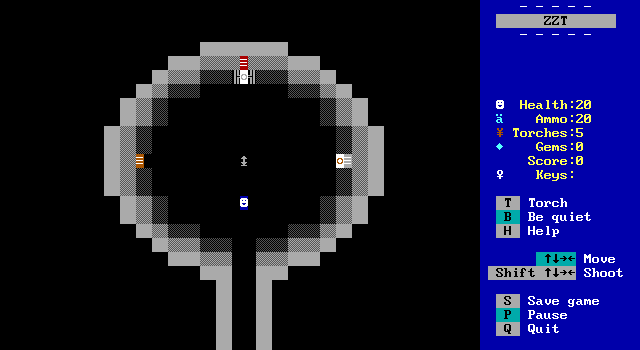
Inside the fortress itself are a small arrangement of rooms behind locked doors (and a single open one) that leads to the next dungeon. There aren't any names provided to the player for each area, but the board names reveal them to be "Crypt", "Tomb", "Mausoleum", and "Necropolis". One aspect of the dungeon crawling that I want to say is a nice touch, but honestly, is essential to this game not feeling tedious is its hub structure. Entering a passage to a dungeon leads to one more board with another series of passages behind locked doors and one open one. The game is structured so that at the end of each dungeon level the player will pick up the key to the next one.
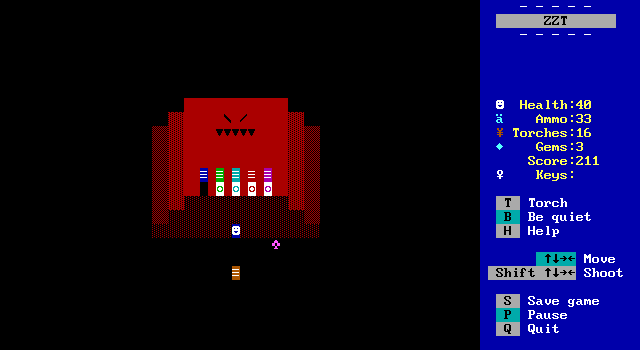
In an example of what is a nice touch, behind each key is then a passage not to the hub, but to the next floor where the player will start next to the actual passage back to the hub. This avoids breaking the game's flow by otherwise forcing the player out of the dungeon. The player instead continues their dungeon crawl until they choose not to. At the start of each dungeon floor is a passage back to the hub, so the keys are instead used not for continuing forward, but for heading back.
There is a bug here with key colors being shared where if you complete two floors in a single dive, you'll have a spare key that you can use to skip ahead in a later dungeon. This could have been mitigated by just using objects, but the honor system works fine. (Plus skipping floors will make it more difficult to obtain points for upgrades.)
Later dungeons do include transporters, but these are just to save the player time if they're retreating to town in the middle of a floor.
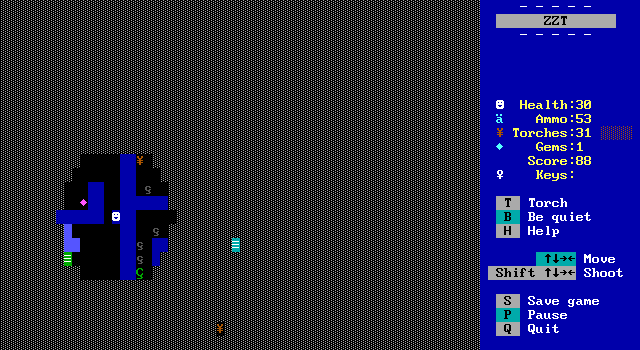
The designs of the dungeons are arguably the game's weakest aspect. Every single level is ultimately a straight line from beginning to end, and there are no decorative floors or objects as set-pieces. Turn the lights on and the game looks a little underwhelming. The foes within the dungeons feel placed somewhat haphazardly, since they'll be running around the entire duration the player is making their way through, which limits opportunities for the game's encounters to be designed for a specific portion of the dungeon.
Normally, this wouldn't be an issue, since ZZT is notoriously difficult to get enemies that feel like anything other than some combination of moving randomly or moving towards the player, but while Weaselfeathers did a great job with the game's upgrade system, what makes Evilstania a true marvel is the design of its enemies.
Bestiary
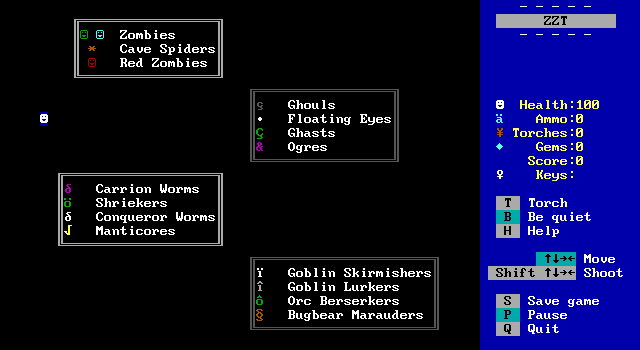
Each dungeon has its own set of enemies, slowly introduced throughout each
level. At first it's just simple zombies that you'd see in any ZZT world, but
the enemy set gets more varied and more devious throughout the game.
Weaselfeathers makes excellent use of combining ZZT's #walk command with standard movement to allow monsters to
move diagonally, rapidly pounce at the player, and just move in ways that make
playing Evilstania stand above its peers.
Evilstania contains sixteen monsters, and never feels like
it's repeating itself. This is a tremendous accomplishment and the game
continued to surprise me all throughout. To focus on one in particular, the
"floating eye" creature impressed me the most. It's a creature that attacks not
with melee, bullets, or stars, but with a dangerous staring attack. If the
player is aligned when the eye object opens, it uses #put to produce a short line of boulders in the player's
direction, then transforms them into *sharks*, waiting a cycle before erasing
them. Since the #put command can be used multiple
times in a cycle, this creates a short range attack that's only a cycle away
from harming the player. It also makes them extremely difficult to fight as
they can only be harmed when the eye is open as well, requiring the player
shoot while the eye is still closed, and time the bullet to hit during the
brief window the eye is opened.
The list of monsters is frankly massive for a ZZT world. Ranging from simple zombies that march slowly towards the player like you'd expect to shriekers that retreat when hit and throw (reduced duration) stars if the player can't chase them down and finish them off. The enemies feel varied in such a way that's really unmatched in ZZT games. Although the always actively running code means enemies bunch together in certain points, their variety in how to approach them really creates some exciting scenarios. A bullet that misses its intended target may go on to hit another monster that becomes extra aggressive when hit. This is the first ZZT action game I've played where I've felt like there's legitimately strategy involved. I found myself working with level architecture, rounding corners, using hit-and-run tactics, and panicking when certain monsters broke to the front of a pack of many. Weaselfeathers smartly avoids one tile wide hallways in all but the earliest levels, giving enemies a minimum amount of room to breathe and express themselves, forcing the player to consider the best approach.
You won't survive long in Evilstania by spamming bullets down the corridors, nor will you get far by trying to hang back while your torchlight slowly burns out. The game excels at its balance, and constantly tempts you with risk/reward scenarios. You'll constantly find yourself making decisions on whether to press forward and risk death or burn out a torch to retreat. Every hit the player takes feels immense with limited HP and the need to pay for healing contrasting sharply with the usually generous 100 health most games start the player with. Sometimes you'll clear an entire floor in one go, taking in lots of points to put towards your character's next upgrade, and other times you'll retreat to heal, stock up on supplies, miss six shots in a row and lose a chunk of health with nothing to show for it.
Not only is Evilstania unique in having monsters that have strategies to fight, but it also features tips that can be purchased with gems found in the dungeons themselves. Outside of each dungeon entrance is an "enterprising minion" that offers advice on any monster found within (as well as bosses) for a price. This adds yet another strategic choice for the player, where you'll have to decide if you want advice on monsters you're already fighting, ones that will be coming up soon, or the boss of the dungeon. There are enough gems in each dungeon to purchase all the advice, but gems are fragile, and the player will likely shoot one accidentally at some point.

The advice offered is actually quite useful too! The enterprising minion will offer information on enemy health and how they attack. The Gem Of Charisma in the tool shop can be used to get extra information which usually consists of information on how best to approach the enemy successfully.
Bosses
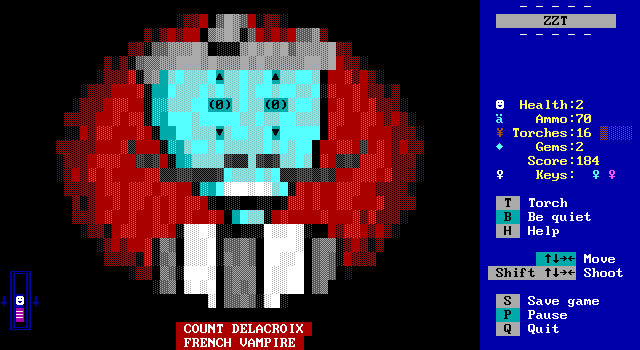
And of course, at the end of each dungeon is a boss battle.
These are interesting in that there is no commitment! The player is free to leave in the middle of the fight and go heal up or get more ammo. The bosses are a lot of fun to fight, and are quite impressive themselves, though admittedly the enemies in the dungeons are more exciting to fight. These fights frequently require lots of fast reflexes (an extra challenge in DOSBox, though the game was obviously designed for it) and keeping track of where the boss is (because it's usually still dark). The first boss, pictured above, was the one that actually gave me the most trouble out of all of them (perhaps because I didn't have enough gems left to get advice on how to beat them). The others took a few tries at most, but honestly don't feel as dangerous as the groups of enemies you'd be fighting just prior.
However, it's the final battle with Von Dread that really puts the rest to
shame. Von Dread has over 750 lines of code, weighing in at just
shy of 12 KB in size out of a possible ~20 KB of memory allocated for a single
board! Von Dread takes up 93% of the space used on the game's final fight
board! He's a ton of fun to fight, and without a doubt the most fun I've ever
had fighting a boss in ZZT to this day. His attacks are varied, the player has
to rely on non-conventional strategies, and Weaselfeathers gives Von Dread some
attack methods that I've never seen used anywhere thanks to very ingenious
usage of the #put command. Throughout the fight Von
Dread will shove the player away by placing a long row of boulders (with a few
in the chain being turned into stars on the next cycle), spawn in rows/columns
of stock ZZT enemies, and even pin the player with linewalls in a cramped
corner that he'll begin another assault in.
I was ecstatic and smiling the whole time with each new attack! Beating Von Dread is tough, but it falls entirely on the player to figure out how to deal with his tricks effectively. It's fair to the point where I'm almost certain with a little practice that it can be won without taking a single hit. It's a challenge to be conquered!
Final Thoughts
Evilstania is a brilliant game. It is doubtless one of the best coded ZZT worlds I've ever seen, showcasing some great boss fights with even more impressive enemy designs. It constantly surprised me how much I had to think about to succeed in it that I never had to pay attention to before. Level design, enemy placement, upgrades, heals, and supplies are all attributes the player needs to stop and think about to do well. It's so rare for a ZZT game to be so utterly balanced. There's no opportunities to be lazy and just cheese your way through, both the grunts and boss fights demand more of the player than anything I've seen in ZZT before.
I do think the game could be a litle more accessible. It's difficulty never felt unfair, but the lack of resources in the early game might make some folks turn away. Just an easy mode that started the player off with some more supplies would probably go a long way to ensuring everyone can complete the game.
But if you're experienced enough with shooting baddies in ZZT, this game will surprise and delight you. It's maybe 2 or 3 hours long, and there's never a dull moment. It's tense, challenging, and feels like all the responsibility to succeed is on the player's own abilities. This one is a must play, and has definitely earned a spot as one of ZZT's all-time greatest.






